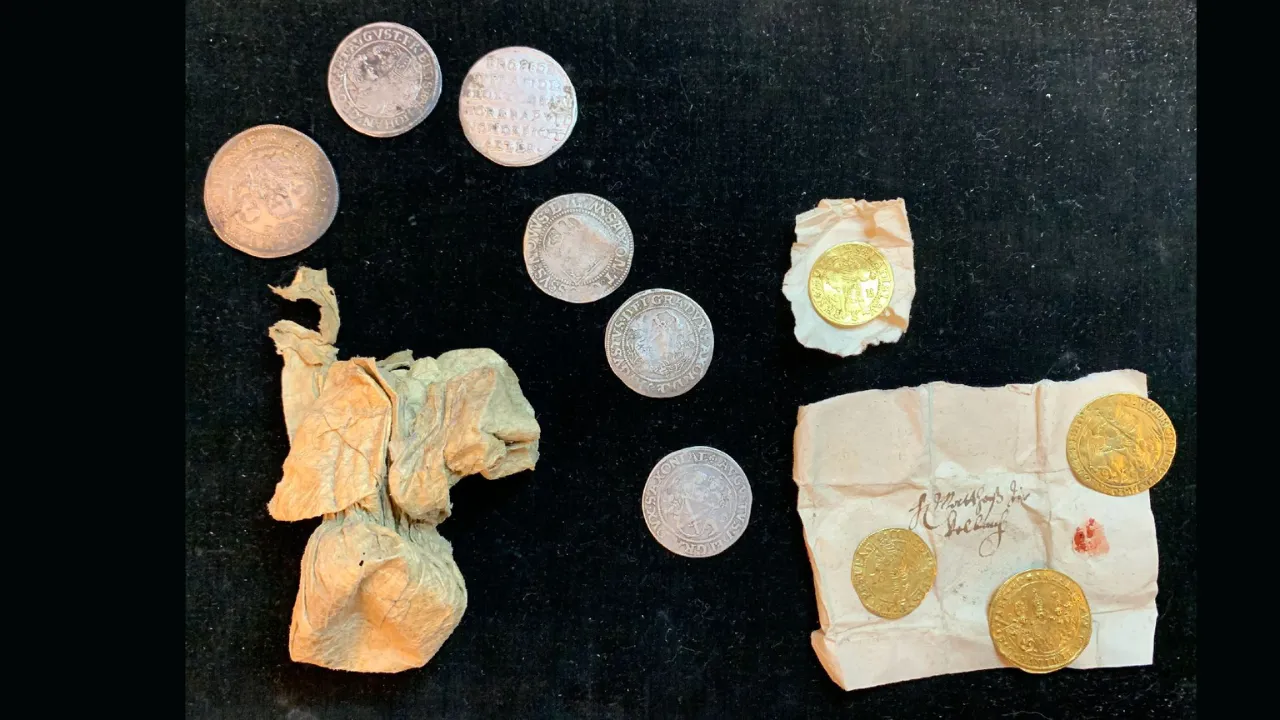Huge Fortune from the 1600s: In an extraordinary archaeological discovery, restorers at St. Andrew’s Church in Eisleben, Germany, have uncovered a huge fortune from the 1600s hidden within a sandstone statue. This treasure, consisting of gold and silver coins, remained concealed for nearly four centuries in the very church where Martin Luther, the iconic Protestant Reformer, delivered his final sermons.
The treasure was likely hidden around 1640, during the chaotic years of the Thirty Years’ War, a time when looting and plundering were rampant. Experts believe the coins were deliberately stashed away to protect them from invading soldiers. With over 800 coins discovered in four tightly sealed bags, this find not only reveals a significant monetary value but also sheds light on the financial practices of 17th-century churches.
Discovery Overview: Key Facts at a Glance
| Detail | Description |
| Location of Discovery | St. Andrew’s Church, Eisleben, Germany |
| Time Period Hidden | Around 1640 |
| Historical Context | Thirty Years’ War |
| Date of Discovery | May 2022 (Announced in November 2024) |
| Contents of the Treasure | Gold ducats, silver thalers, pennies, golden angel coin |
| Estimated Value | Significantly more than a craftsman’s annual income in the 1600s |
| Intended Purpose | Likely part of a church treasury fund |
| Current Location | Moritzburg Art Museum, Halle |
A Hidden Treasure in a Historic Church
The huge fortune from the 1600s was found inside the leg of a sandstone statue at St. Andrew’s Church, a historically significant Gothic structure. This church holds deep historical importance, as it hosted Martin Luther’s last sermons in 1546.
The discovery was made during a routine restoration project in May 2022, but it wasn’t publicly announced until November 2024. Hidden in the cavity of the statue’s leg were four leather bags filled with coins, tightly packed to ensure they remained undetected for centuries.
The timing of the treasure’s concealment aligns with the turbulent Thirty Years’ War — a devastating conflict that saw widespread destruction and looting across Europe. The church, likely seen as a secure place during these uncertain times, became a secret vault for safeguarding valuable assets.
What Was Found in the Treasure?
The treasure trove included an impressive collection of over 800 coins, reflecting the wealth and financial systems of 17th-century Europe. Among the coins discovered were:
- Gold ducats and double ducats
- A rare golden angel coin
- Silver thalers, half-thalers, and quarter-thalers
- Hundreds of silver pennies
Some coins were carefully wrapped in paper and labeled, suggesting that they were part of an organized financial fund, possibly belonging to the church treasury. These funds were likely accumulated from weddings, baptisms, funerals, and chair fees, which congregants paid for premium seating during church services.
Why Was the Treasure Hidden?
The period around 1640 was marked by the devastation of the Thirty Years’ War, which brought destruction, famine, and violence across Europe. Churches, often seen as safe havens, were frequently targeted for their wealth.
The person who hid these coins — possibly a church official or someone closely tied to the church’s finances — likely intended to safeguard them from plundering Swedish troops.
Historians speculate that the coins might have been part of the Aerarium Pastorale, a parish fund used for pensions, healthcare for pastors, and theological education. If confirmed, this discovery would provide a rare glimpse into how church finances operated in the 1600s.
The Historical Value of the Discovery
This huge fortune from the 1600s is more than just a collection of valuable coins — it’s a window into history. Each coin represents a piece of the economic and cultural landscape of 17th-century Europe.
According to Ulf Dräger, curator of the State Coin Cabinet of Saxony-Anhalt, the treasure represents “a highly significant historical testimony, not just for Eisleben, but for the entire state of Saxony-Anhalt.”
The discovery also highlights how wealth was managed, hidden, and protected during periods of conflict. It’s not just about monetary value but about understanding the fears, priorities, and strategies of people living in uncertain times.
The Value of the Treasure in the 1600s
To understand just how valuable this huge fortune from the 1600s was, it’s important to consider the economic conditions of the time:
- A skilled miner earned 1 thaler per week.
- 1 pound of butter cost 3 pennies.
- Two herrings cost 2 pennies.
With over 800 coins, including high-value gold and silver pieces, this treasure represented a fortune that far exceeded what most craftsmen or workers could earn in their entire lifetimes.
Losing such wealth would have been an unimaginable tragedy for its original owner, which makes the discovery all the more poignant.
What Happens to the Treasure Now?
The coins are currently under the care of the Moritzburg Art Museum in Halle, where they are being meticulously examined, cataloged, and preserved. Researchers aim to study each coin individually, documenting its origin, material, and historical context.
Additionally, plans are in place to showcase the coins to the public, both online and at St. Andrew’s Church. This ensures that the treasure’s historical significance can be appreciated by future generations.
The Lutherstadt Eisleben Protestant Parish Association has also been instrumental in ensuring the coins are available for research and public display.
FAQs About the Huge Fortune from the 1600s
1. Where was the treasure found?
Inside a sandstone statue at St. Andrew’s Church in Eisleben, Germany.
2. How old is the treasure?
The coins were hidden around 1640, nearly 400 years ago.
3. What types of coins were in the treasure?
The treasure included gold ducats, double ducats, silver thalers, and hundreds of pennies.
4. Why was the treasure hidden?
It was likely concealed during the Thirty Years’ War to protect it from plundering troops.
5. Can the public view the treasure?
Yes, the treasure will be displayed at the Moritzburg Art Museum in Halle and St. Andrew’s Church.
Final Thoughts
The discovery of this huge fortune from the 1600s at St. Andrew’s Church in Eisleben is a remarkable reminder of Europe’s turbulent past and the lengths people went to protect their wealth.
As researchers continue to study the treasure, more secrets are likely to be revealed. For now, this find stands as a testament to resilience, history, and the enduring legacy of one of Germany’s most iconic churches.
What are your thoughts on this incredible discovery? Share them in the comments below and stay tuned for more updates on this historic treasure!
















